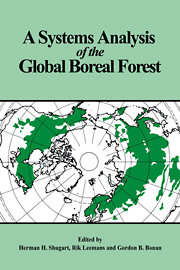Book contents
- Frontmatter
- Contents
- List of contributors
- 1 Introduction
- Part 1 Processes in boreal forests
- Part 2 Patterns in space and time in boreal forests
- Part 3 Computer models for synthesis of pattern and process in the boreal forest
- Introduction
- 12 Individual-tree-based models of forest dynamics and their application in global change research
- 13 Population-level models of forest dynamics
- 14 A spatial model of long-term forest fire dynamics and its applications to forests in western Siberia
- 15 A simulation analysis of environmental factors and ecological processes in North American boreal forests
- 16 The biological component of the simulation model for boreal forest dynamics
- 17 Role of stand simulation in modeling forest response to environmental change and management interventions
- 18 Concluding comments
- References
- Index
15 - A simulation analysis of environmental factors and ecological processes in North American boreal forests
Published online by Cambridge University Press: 12 January 2010
- Frontmatter
- Contents
- List of contributors
- 1 Introduction
- Part 1 Processes in boreal forests
- Part 2 Patterns in space and time in boreal forests
- Part 3 Computer models for synthesis of pattern and process in the boreal forest
- Introduction
- 12 Individual-tree-based models of forest dynamics and their application in global change research
- 13 Population-level models of forest dynamics
- 14 A spatial model of long-term forest fire dynamics and its applications to forests in western Siberia
- 15 A simulation analysis of environmental factors and ecological processes in North American boreal forests
- 16 The biological component of the simulation model for boreal forest dynamics
- 17 Role of stand simulation in modeling forest response to environmental change and management interventions
- 18 Concluding comments
- References
- Index
Summary
Introduction
The boreal forest biome is a broad circumpolar mixture of cool coniferous and deciduous tree species that covers approximately 17% of the world's land surface area. Throughout this region, the landscape is a mosaic of forest vegetation types. For example, in interior Alaska above-ground tree biomass ranges from 26 t ha−1 for black spruce (Picea mariana (Mill.) B.S.P.) forests growing on cold, wet, permafrost soils to 250 t ha−1 for white spruce (Picea glauca (Moench) Voss) forests on warm, permafrostfree sites (Van Cleve et al. 1983b). In northern Quebec, above-ground tree biomass averages 20 t ha−1 in nutrient-poor black spruce–lichen woodlands and 108 t ha−1 in more fertile black spruce–moss forests (Moore & Verspoor 1973). In the warmer jack pine (Pinus banksiana Lamb.) forests of New Brunswick, above-ground tree biomass ranges from 0.8 t ha−1 for recent burns to 91.1 t ha−1 for more mature stands (MacLean & Wein l976).
Numerous researchers have examined specific aspects of boreal forests, but no one has formulated a unifying model of the boreal forest biome, a paradigm to link the pattern of forest vegetation with causal environmental factors. Our most detailed understanding of the ecology of boreal forests comes from interior Alaska, where interactions among soil temperature, permafrost, soil moisture, the forest floor, litter quality, nutrient availability, and fire largely control forest productivity and vegetation patterns (Lutz 1956a; Heilman 1966; Viereck 1973, 1975; Van Cleve, Barney & Schlentner 1981; Van Cleve & Viereck 1981; Van Cleve et al. 1983a,b; Van Cleve & Yarie 1986).
- Type
- Chapter
- Information
- A Systems Analysis of the Global Boreal Forest , pp. 404 - 427Publisher: Cambridge University PressPrint publication year: 1992
- 10
- Cited by



